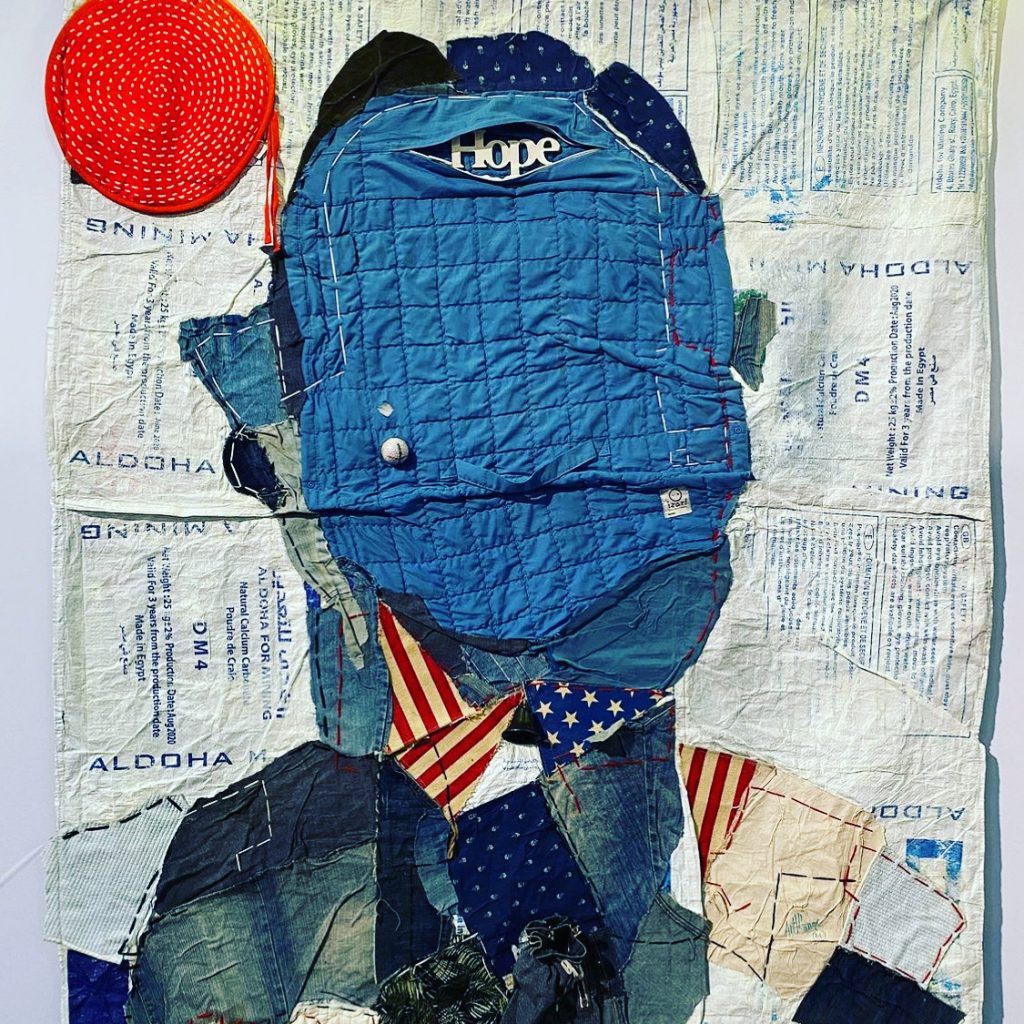Artist Ange Arthur Koua, born in Ivory Coast (Abidjan) in 1989, has created a striking body of work using various symbolic materials, specifically emphasizing worn garments and fabric. His work is both personal and political, without a specific agenda. He gives us the freedom to understand what is often unspoken. Ange’s first solo exhibition in Germany, “un balance/balance,” was celebrated at Atelierhaus Aachen.
Mastery of the technical and aesthetic principles of drawing and design is evident in the artist’s work; he embraces and escapes tradition. His portraits give us a look into our individual and collective minds, literally and figuratively. Often without eyes, the emblematic heads are close enough in scale for us to identify with them. Sometimes they are sewn together, with drawing or painting over the fabric. They are both masks and windows into the soul.
The material that I use the most (textile) is not necessarily an act of recycling but rather that of the restitution of stories that these pieces of fabric have been able to record. The garment bears the mark of its user, their DNA signature, personality…it is, therefore, a very important piece of evidence. All my creation is based on the principle of telling stories with real elements about those who have lived in them. Ange Arthur Koua
In the larger work, our relationship to it changes object, window, or banner, often interchangeably. Drawing and painting with fabric, textiles, and found objects as well as traditional materials, the work remains faithful to its 2-dimensional origins. The use of flat shapes is often juxtaposed with multiple textured areas. Black borders provide a space for the shapes to interact. The asymmetrical designs are simple and striking. Both primal and elegant at the same time. Occasional use of brilliant primary color accentuates the thematic scheme. Negative shapes are as important as those that depict things, ideas, or people. The materials themselves are symbolic within their intentional arrangements, parts of garments, and fabric relating to the popular belief in the east of the Ivory Coast that the soul of the deceased clings to their clothes.
The featured work, Iconoclaste 2, is a portrait made up of fragments of fabric, textiles, garments, worn pages, a roll of felted material forming a circle on the upper left corner, and bits of photographs or text from magazines. At first glance, we see the unmistakable shape of a human head with unsettling paradoxical features. The opening at the top from which we read the word HOPE, white letters on a blue ground, seems like a mouth. A significant word is in the mouth. It separates itself from the text surrounding the head, which functions more as a field, vaguely patterned, low contrast, washed away and faded. We don’t need to read the background. HOPE, on the other hand, is a charged, universally recognized idea. It creates a powerful message. The surface texture is arranged and integrated with pattern – the red and white stripes suggest an American flag, the blue field with white stars, the grid-like quilted design in the large blue shape of the head, and even the sewn white stitches all play an essential role in this compelling composition.
Ange’s larger pieces honor contemporary postmodern African American artists such as Romare Bearden, Aaron Douglass, Faith Ringgold, Jacob Lawrence, and Jean Michel Basquiat. This work has the very best of what makes art authentic, an honest desire to communicate a human response to a rapidly changing global world.
featured work: Iconoclaste 2, textile mixed medium, 150 x 220 cm
Carol Heft is a New York City-based artist and educator. She is a graduate of the Rhode Island School of Design and her work has been exhibited internationally. She teaches Drawing, Painting, and Art History at several colleges in New York and Pennsylvania, and is represented by the Blue Mountain Gallery in New York City.












